|
|
|

History of Daytona USA
Much like any genre of games in the 80's/90's, a transition was made from 2-D to 3-D images. Sprites were being replaced with polygons, which were at first rudimentary, single-colored blocks, but eventually became textures, much likes games you see today. Stuff like Super Mario 64 and Quake were firsts in their respective fields. The same thing happened with racing games. Cars usually came in the image of sprites that puttered around either a top-down view (Super Sprint, Ivan "Ironman" Stewart's Super Off-Road) or from a traditional "behind the car" view that tricked you into thinking you were in three dimensions, though you really weren't by the magical effects of parallax scrolling (Pole Position, Outrun, Chase HQ). In the early 90's, sprites gave way to polygons, and a whole line of Sega racers bloomed. These efforts were mostly brought about by Sega Amusement Machine Research and Development Department 2 (otherwise known as Sega AM2, or just AM2), and we are in their debt.
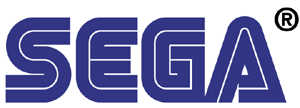
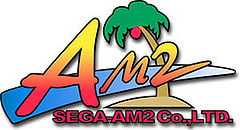
Here is a quick summary of games leading up to Daytona USA:
280 ZZZAP (1976)
Believe or not, this is the first racing game ever conceived. The concept was that you drove a car from the first person view and stayed within the white dots, which obviously simulate a road. The cabinet came with a steering wheel. The "car" in this game was not rendered--instead a plastic cutout was stuck in front of the monitor to "simulate" the concept of steering a bona-fide car. This game is very rare today. But yeah, that was pretty cool and racing games could only improve from here on out.
Pole Position (1982)
Namco was in a groove with multiple arcade hits--Pac-man, Galaga, Dig Dug, and freaking Pole Position. Like 280 ZZZAP, the cabinet came with a steering wheel as well as a pedal and a two-gear shift stick. The concept was to drive around an altered version of the famous Fuji Speedway. Physics were implemented such that the driver had to slow down on turns and use the manual transmission to accelerate quicker. Collisions with billboards or other drivers led to a nasty fireball that wasted precious seconds. The first "good" racing game--it made parallax scrolling popular.
Hang-On (1985)
This is the first racing game created by Sega AM2's department under Yu Suzuki, who would later go on to be responsible for the OutRun series as well as many other Sega classics, such as Virtua Fighter, Virtua Cop, and Shenmue. The motorcycle-shaped cabinet allowed the player to lean left and right to steer and twist the handle to accelerate. Parallax scrolling was still in effect. The interface seen here would be very similar to the one used by OutRun a year later.
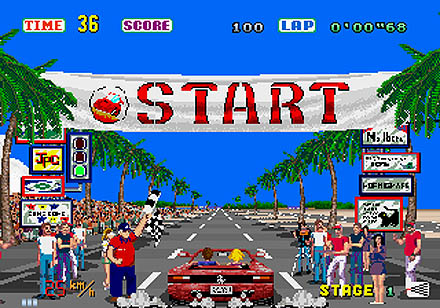
OutRun (1986)
Sega AM2 and Yu Suzuki struck gold with this fast-paced parallax racer that continues where Pole Position left off. Like Pole Position, players drive a car and shift between two gears and use a pedal to accelerate. The gist is that you are no longer racing against opponents per se, now you are racing against the clock in a Ferrari Testarossa. Weave through traffic to avoid nasty wrecks and loss of speed. At the end of each stage lies an intersection and players can choose to take a left or right, which will lead to a different stage. A very unique idea that was also bolstered by its incredible soundtrack. To this day, "Splash Wave," "Magical Sound Shower," and "Passing Breeze" still mesmerize gamers. Several OutRun spinoffs were created years later, such as Turbo OutRun and OutRunners. Sega gets its racing mojo with this game.
Hard Drivin' (1989)
The first true bonafide three-dimensional racing game. Atari created what could very well pose as a driving instructor's tool, but instead, it is used as an arcade game. Much like OutRun, the player drives a sports car through checkpoints and avoids wrecks with traffic. Realistic "physics" are used so that players must slow down and even shift (if the player chose manual transmission). A huge step forward for racing games.
3-D graphics have broken through. In the 90's, a series of Sega racers will explode on the scene. The first one of them is Virtua Racing. Released in 1992 by Sega AM2 and run on the Model 1 board, this Formula 1 racer did many things for the series and set many standards by which arcade racers in general follow today.
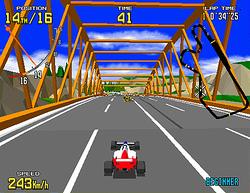
1. The Drifty Physics
The handling in Virtua Racing could be described as very "loose." When you turn, the car will "slide in" automatically (this is unusual considering F1 cars are designed for max grip and downforce and thus hardly ever slide). Unlike in Daytona USA, there is no need to set up the slide by using the brakes or the shifter. This free-and-loose handling would come into play in numerous games to follow.
2. The Multiple Course Selection
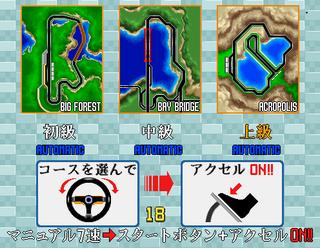
Virtua Racing is the one of, if not, the first to offer three courses. One is labeled as "easy," the second is "medium," the third is "hard." The three courses were different in scenery--Big Forest featured plenty of trees and easy turns and a carnival in the distance, Bay Bridge was in a tropical setting with a Golden Gate Bridge replica and palm trees, and Acropolis featured a mountain range and sailboats in the lake.
3. The Option to Choose Automatic or Manual Transmission
This is a biggie. After choosing a course, the player has the option to pick either automatic or seven-gear manual transmission? So what does this mean? Manual became that luxurious "advanced" choice that professionals longed for. It ensured slightly better acceleration and top speed, which would come into play in Daytona USA and Scud Race. While the manual transmission in this game was purely for acceleration purposes and not to incite a drift, it would later be used for that purpose as well in those games.
4. The Link System
What good was a racing game if you couldn't race other people? Virtua Racing was arguably the first game to do so with gusto. The Link System hookup allowed up to eight players to race simultaneously. This would later prove to be crucial to Daytona USA's success as a racing series.
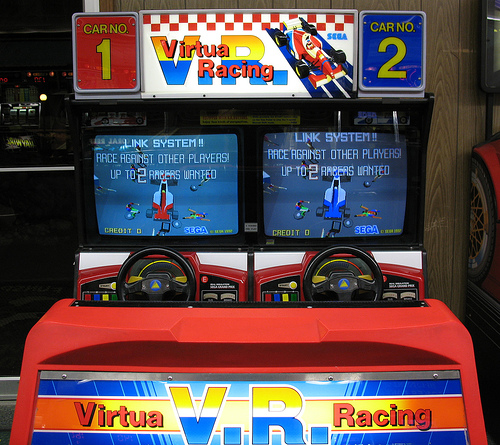
5. The Home Ports
Yes, you know about 'em, you love 'em, you hate 'em, etc. Like Daytona USA and OutRun, Virtua Racing saw console ports to the Sega Saturn, the Sega Genesis/Megadrive, the Sega 32X, and the PlayStation 2 (this one was years later). Unlike many of the OutRun/Daytona ports, the Virtua Racing ports were considerably good compared to other console games but they couldn't compare to the arcade version, of course.
6. The Polygonal Graphics
Duh, what did you expect, that Sega would go from sprites in OutRun all the way to textured polygons in Daytona USA?
I could go on but you get the idea.
In 1994, Amusement Vision director Toshihiro Nagoshi came up with the idea to follow up Virtua Racing. He wanted to create a faster, more loose racing game and use cars that were more "able-bodied" (i.e. able to take a beating). The new Model 2 board handled more polygons on screen than previous titles. And thus, Daytona USA was born.

Here is the infamous attract screen, stare at it in awe:
The gist behind Daytona USA was similar to that of Virtua Racing--this time, with traditional stock cars a la NASCAR. The player picked a track, manual or automatic, and tried to finish the race. Checkpoints dispersed around the course awarded the player with bonus time. As you can see below, the format is similar to that of Virtua Racing. The race ended when the player either finished the amount of allotted laps or when time ran out.
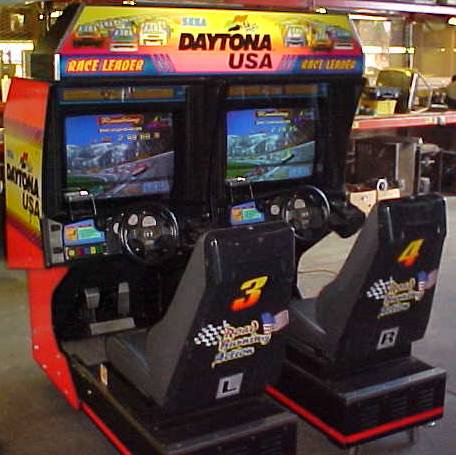
The courses featured three circuits of varying difficulty (though the amount of laps varies, it is very rare to see Beginner course with more than 8 laps for instance). The cabinet's famous four-gear layout would be used in MANY arcade racers to follow, such as Cruisn' World and San Francisco Rush. As you can see, manual transmission provided a slight increase in horsepower (Top Speed Automatic: 196 mph (315 kph), Top Speed Manual: 201 mph (323 kph) though your car CAN go faster than this if you slipstream/drive downhill). The famous Hornet car, based off of a 1994 Chevrolet Lumina, would reach superstardom overnight. Knight Rider, the Batmobile, the DeLorean, the Hornet car. Oh yeah.
In terms of art style, Daytona USA picks up where Virtua Racing left off. High-res textures were used. Framerate ran at a smooth 60 FPS. View distance increased. The three courses were laden with new scenery. The Beginner oval (otherwise known as Three-Seven Speedway), loosely based off of the real Pocono Speedway was a run through the forest, by Sonic Mountain, and past stands of fans. The Advanced circuit (known as Dinosaur Canyon) was a run through a huge valley, through a tunnel, and by a cliff, complete with wind generators. The Expert course (known as Seaside Street Galaxy) was across a huge two-lane suspension bridge, zipping through town and by a huge space shuttle. The idea to use such broad scenery was unprecedented for its time.
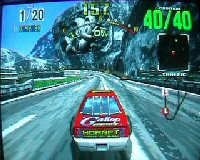
The game was
also the first to use the new powerslide system. While turns can be taken
in the traditional manner (step on brake, corner), Daytona USA allows you
to do so by drifting/powersliding. This can be done in two ways--either by
tapping the brake or downshifting and upshifting quickly. Powersliding is
useful for cutting lap times, but it is difficult to do. This was the
icing on the cake on what would become the most popular arcade racer of all
time!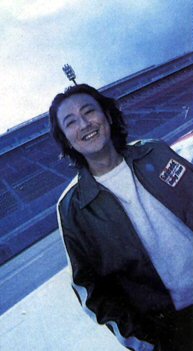
Daytona USA would also do some other unique things. It would continue the tradition of Link System and allow up to eight people to race together. Damage models were included so that a tap with the wall or a head-on collision would result in the car's body being mangled in some way (there is no way to totally incapacitate the car though). And also, the famous soundtrack, with lines such as "Roooollllinnnnng Staaaarrrtttt!" "Do do do do do do do do do do DAAYYYYTTONNAA!!" and "I wanna flyyyyiyy SKYY HIGH!!!" still entertain people today (see the Soundtrack page to hear it).
Toshihiro Nagoshi on the right --------------------------------------------------------------------------------->
While Sega AM2 was busy at work on their next ace in the hole game, it experienced pressure from other companies who were out to make a name for themselves. Among the most relevant is Namco, whose previous work Pole Position, prompted them to make Ridge Racer. Ridge Racer ran on the Namco System 22 board and was released for arcades in October 1993 (which was very, very close to Daytona's release) and for PlayStation a year later. The game had many similarities to that of Daytona USA, such as the ability to choose Automatic or Manual, and the game's intense time requirements. However, players drove race-modified sports cars as opposed to the usual lineup of stock cars. The Ridge Racer series would eventually grow and multiple home ports would emerge, such as the most recent Ridge Racer 7 for the Xbox 360 and PlayStation 3.
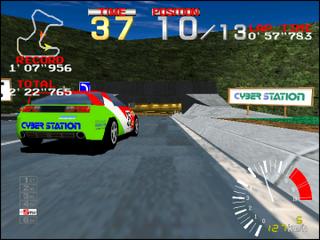
Even though this is a Sega-themed website, you have to give props to Ridge Racer. The series lasted for a long time and it pays tribute to the classics with little references to classics like Pac-Man, Galaga, and Dig Dug. Plus it gave Sega something to compete with. Had Ridge Racer not existed, there may not have been the extravagant line-up of Sega racers to follow.
Also, at the time, Sega would go into it's port-happy phase. Ports of Daytona USA were created for the Sega Saturn and PC. None were considered very good, as they were plagued with short draw distance, inconsistent framerate, and jagged textures. How you can dumb down something like Daytona USA is beyond comprehension to me. An unofficial "sequel" to Daytona USA was created called Daytona USA: Championship Circuit Edition (otherwise known as Daytona USA Deluxe on PC) in 1996. While Daytona USA: Championship Circuit Edition feels more like your traditional racer (more tracks, a handful of cars with varying statistics), it felt a bit dry compared to other entries in the series due to a somewhat lackluster powersliding engine.
The irony is that this game wasn't created by Sega AM2 like previous titles were, it was created by Sega Rosso, another subsidiary of Sega which previously created Sega Rally Championship in 1995 and would later go on to create the Initial D: Arcade Stage series in 2001. Sega Rally is considered an excellent racing title, though it being sandwiched between two stellar pavement racing games didn't help it any. As you may have guessed, you race against the clock in one of multiple courses and slide along the dirt. Unlike Daytona USA, this game featured multiple cars to choose from, such as a Lancia Delta or Toyota Celica.
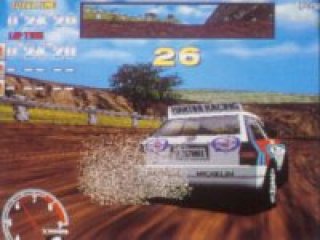
Sega AM2 strikes back with their third game of the decade called Scud Race released in 1996 (also known as Sega Super GT outside of Japan to avoid confusion with scud missiles, I don't make this stuff up). Some people consider it the spiritual sequel to Daytona USA since it was released two years earlier (though there is a Daytona USA 2, hopefully you knew that already without having to go down the page). The letters in "Scud" stand for "Sports Car Ultimate Drive," and in this game, you get to drive one of four high-performance production cars on four tracks. Four cars, four tracks. We're breaking new ground here (cause more stuff is good right?).

Scud Race continues tradition by boasting a high sense of speed, tons of lavish scenery, and the same complex yet highly-rewarding gameplay of the series. Now running on the new Model 3 board, the game runs at a slick 60 FPS with nearly unlimited draw distance. Car models are fantastic. The four cars--the Porsche 911, the Ferrari F40, the Dodge Viper, and the McLaren F1, are not only visually stimulating but come with their own tendencies. In that order, the Porsche is the easiest to control but has the lowest top speed and acceleration while the McLaren is the exact opposite. Courses include a run through an aquatic tunnel (complete with dolphins), a bustling airport at night, ancient ruins from South America, and a medieval castle. Seriously, what was the last game you played that came close to matching this scenery (F-Zero doesn't count, and Cruisn' Exotica is too generic to stand for anything)?
Car control has changed since Daytona USA. While powersliding in this game is a viable option, control during slides is paramount. In Daytona USA, a car in a slide can typically be straightened out quite easily. In Scud Race, it's not hard to throw the car into a 360 spin and come in contact with the wall. I guess, for lack of a better description, this game is similar to Bizzare and Microsoft's Project Gotham Racing series, except that powersliding actually helps you. You can still use the four-gear shifter to your advantage, but it's different than before.
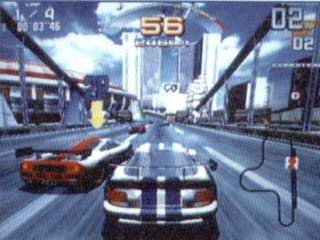
Like previous racers, you can race Link System with multiple people and race against the clock. As you can see, Sega isn't going to deviate from this idea any time soon. Also exists is a modified version of Scud Race known as Scud Race Plus, which features a bonus course--driving a toy truck through a room like out of Toy Story. This version is very rare, but good for the epic lulz.
I think that, at this point, you may have gained an understanding of Sega racing games. In 1996, you had stuff like Super Mario 64 and Goldeneye 64 and the epic classic Cruisn' World. Compare that to Scud Race in motion (ok, I know that I'm comparing home consoles to arcades, but you get the point). But there was no game that was more ahead of its time than Daytona USA 2. The fourth racing game released by Sega AM2 this decade under Toshihiro Nagoshi, released in 1998.

Thus far, Scud Race and Daytona USA 2 haven't seen the light of an arcade port like Virtua Racing and Daytona USA have. Look at it this way. Rumors of a Scud Race port for the Sega Dreamcast existed, yet the project was trashed because the Dreamcast hardware couldn't handle it. The Sega Dreamcast couldn't handle Scud Race, but it could handle Sonic Adventure 1/2 and Soul Calibur? We're talking about the stuff of legends here.
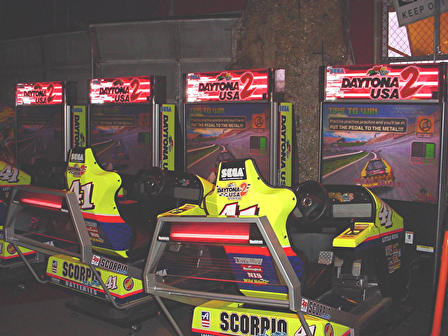
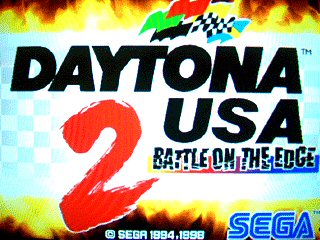
Daytona USA 2's visual style picks up where Daytona USA left off--stock cars, yet with a more "intense" feeling. The cars fit the NASCAR niche much more. Hollow roar of the engine, wrecks with pieces of the car peeling off, smoking powerslides, and epic race ballads are in order. The handling is very similar to that of Scud Race, though it is arguably more forgiving to keep the car in control during a slide. The three courses take place in three new locations--one in a gigantic glass dome complete with a lush jungle and waterfall, a crazy amusement park with several themed sections, and a huge New York/Chicago-like city environment.
I mean, driving the car down the road at 210 mph, watching the car bob up and down oh so slightly with the "RRRAAAAAAAHHHHHHH" sound is probably the greatest sensation I've ever experienced in a game. EVER. The smoking powerslides are cool too (see below).
For some reasons that allude me, hardcore fans of the original Daytona USA dislike the official sequel, saying the series has lost its "grace." What for? If it was too similar to the original, people would still complain. Sega AM2 comes up with a new look, and I've yet to see another arcade racer come close to the professionalism of the game. While any game with a "2" slapped on the end of the title won't win any originality awards any time soon, the source material is excellent and creative.
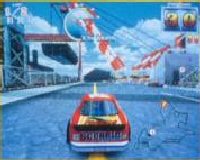

The lineup of cars are cool. Fictional sponsorships the norm these days. The Phantom car's ghastly face always mesmerizes me.

In the same year, Sega AM2 released a patch and thus Daytona USA 2 became Daytona USA 2: Power Edition. Changes include replacing the original Beginner course with a Daytona International Speedway replica (which is kind of a bummer since the dome was beautiful on its own), the car skidpad ratings improved slightly (I'm not sure what the purpose for this is), and the Chums Gum Beginner car was replaced with a less "kiddy" version with different sponsors. A remodeled version of the Hornet makes an appearance, complete with the same handling as in the original. Also, a new "Challenge" course was created, which is essentially one three-minute long lap through each course in the game.
Since 1998, Sega AM2 wouldn't release another arcade game in collaboration with Toshihiro Nagoshi again (though they would return without him some day). Sega arcade racers succumbed to the dwindling status of arcades in general. Before Sega's last stand on the Sega Dreamcast, one last Daytona USA would be released. In 2001, Sega releases one final Daytona game for the fans, otherwise known as Daytona USA 2001 (or sometimes known as Daytona USA, kind of like Sonic the Hedgehog on 360/PS3, depending on your location). This would be the last time the Daytona name is used in the series. The game was created by Toshihiro Nagoshi, but just under the Amusement Vision subsidiary and not with AM2.
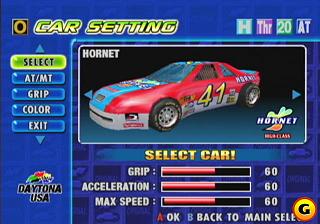 Daytona
USA 2001 is a new version of Daytona USA built from the ground-up.
Boasting ten cars, eight unlockable courses, and a few other little features, it
should be enough to satisfy the appetite of any fan. However, it does not
"exactly" cover the original version. It also lacks any content whatsoever
pertaining to Scud Race or Daytona USA 2.
Daytona
USA 2001 is a new version of Daytona USA built from the ground-up.
Boasting ten cars, eight unlockable courses, and a few other little features, it
should be enough to satisfy the appetite of any fan. However, it does not
"exactly" cover the original version. It also lacks any content whatsoever
pertaining to Scud Race or Daytona USA 2.
The car handling is almost identical to that of the original Daytona USA. Similar tactics that can be used in the arcade version can also be used in the Dreamcast version. The four gears are mapped to the four buttons on the Dreamcast controller. The cars range from incredibly slippery handling with high top speed, to the hardcore grip car with lesser horsepower.
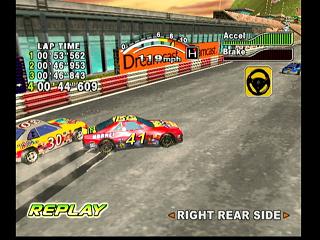 If anything, Daytona USA 2001 can be best described as a glossy, shiny
version of the original. The reflection and the
texturing of the cars and tracks are beautiful. Framerate and draw
distance are stellar. The ten cars are completely original, but none
resemble any existing cars from the series. As a matter of fact, five of
them aren't really "cars"--they consist of a rocket car, a pace car, and three
tongue-in-cheek references of Sega AM2 fighter Fighting Vipers. The
eight courses consist of the three original, as well as two from Daytona USA:
Championship Circuit Edition and three original high-speed circuits.
The soundtrack consists of remixed versions of existing tunes. Color
change, time trial, split-screen multiplayer, saved replays, and tires which change between high grip/easy powersliding
round out the remaining features.
If anything, Daytona USA 2001 can be best described as a glossy, shiny
version of the original. The reflection and the
texturing of the cars and tracks are beautiful. Framerate and draw
distance are stellar. The ten cars are completely original, but none
resemble any existing cars from the series. As a matter of fact, five of
them aren't really "cars"--they consist of a rocket car, a pace car, and three
tongue-in-cheek references of Sega AM2 fighter Fighting Vipers. The
eight courses consist of the three original, as well as two from Daytona USA:
Championship Circuit Edition and three original high-speed circuits.
The soundtrack consists of remixed versions of existing tunes. Color
change, time trial, split-screen multiplayer, saved replays, and tires which change between high grip/easy powersliding
round out the remaining features.
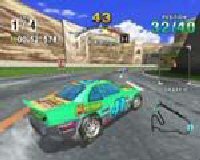 Daytona USA 2001 is the last remnant of the series, so to speak. The
game originally boasted online play with up to four people--however, when the
Dreamcast tanked, the servers were immediately taken down. I have never
had the pleasure of getting the chance to do so, as I bought my Dreamcast years
before the servers went down some time in 2002-2003.
Daytona USA 2001 is the last remnant of the series, so to speak. The
game originally boasted online play with up to four people--however, when the
Dreamcast tanked, the servers were immediately taken down. I have never
had the pleasure of getting the chance to do so, as I bought my Dreamcast years
before the servers went down some time in 2002-2003.
Afterwards, the great Daytona series, along with the accomplished Scud Race ceased to exist. Sega quickly tanked and many arcade classics were being ignored. Arcades succumbed to the overwhelming fury of Cruisn' World and Hydro Thunder. The Daytona trademark was licensed to Electronic Arts, who used it in their series of NASCAR games and the arcade simulator, NASCAR Arcade. If you were a fan like I was, this was a dark time for the series.
However, there was one glimmer of hope--Sega AM2 creates the latest outstanding racer in 2003 called OutRun 2. While in theory it is not the real sequel to OutRun (like Daytona USA 1 to 2), it is a three-dimensional replica of the original, complete with a huge lineup of Ferraris and unique scenery. It ran on Sega's new Chihiro board. It would later come home to Xbox in 2004, thanks to the work of Sega AM2 and European developer Sumo Digital.
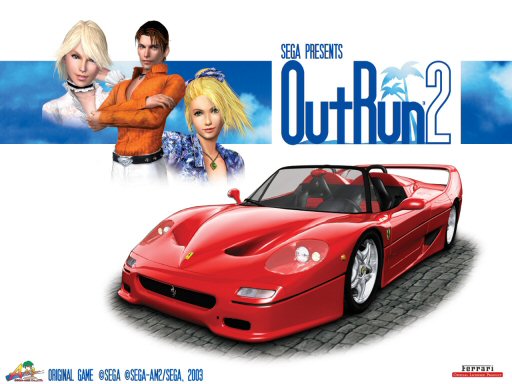
As you may have guessed, powersliding plays a huge role in this game. This game can best be described as "on-rails," generally, you can ride out powerslides out really worrying about spinning out. Powerslides are initiated with the good-old "downshift-upshift" maneuver. It is actually possible to complete a route without using the brakes whatsoever, though this is very difficult to do. Traffic will still present a problem, and should you flip your ride, your passenger will scold you, of course. Run out of time and it's game over.
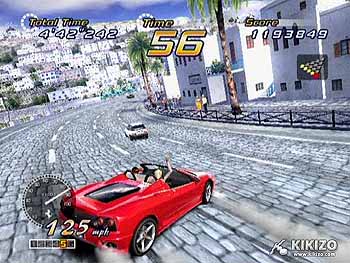
Like the original, you and your girlfriend drive one of numerous Ferrari models through traffic and carve your own path through the landscape. The original 2003 version included 15 courses based on European landmarks (such as the Alps, Rome, or Paris) while the newer OutRun 2 SP version included 15 more courses based on American landmarks (such as Las Vegas, San Francisco, and Aztec ruins). The Xbox port even included bonus courses with are near-identical replicas of the courses from Scud Race and Daytona USA 2, modified specifically for this game. Though the new OutRun 2006: Coast 2 Coast game for PlayStation 2, Xbox, and PC features both the original and SP courses, they lack the bonus courses from the original Xbox game.
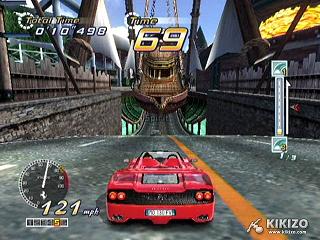
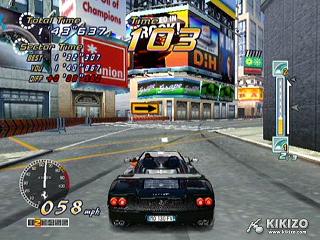
So now you have gained an understanding of Sega AM2 racing games. I hope this article has been informative to you. As of 2009, we do not know what new games will come out in the future. Thanks for reading.
This site is not affiliated with Sega or Amusement Vision. All intellectual properties copyright of Sega®. Some images credited to The Killer List of Video Games®, The Arcade Flyer Archive®, and Sega Museum®.
.